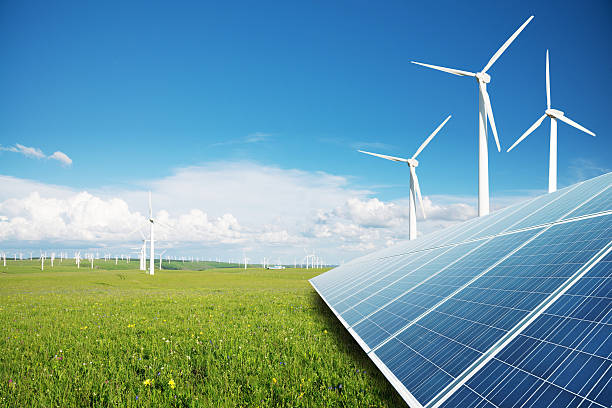The most popular green energy substitutes for fossil fuels among the various renewable energy sources are wind and solar energy. Reducing our reliance on fossil fuels, they are very important. Solar panels and wind turbines are the tools used to harvest energy from the sun and the wind. Solar panels use photovoltaic cells to convert solar radiation into electrical energy.
Furthermore, solar energy includes wind. The sun’s radiation changes the atmospheric pressure, which results in wind. It is a type of energy based on motion.
The turbine’s generator transforms the energy of the rotating blade into mechanical power when the wind turns the blades. It is then transformed into electric power, which can be used to run both residential and commercial sectors. Domestic energy sources include the wind and sunlight. It is unbounded, abundant, and sustainable.
What is Solar Power?
Sunlight makes up about 12–15% of all renewable energy. We can collect the solar radiation that falls on the Earth by using solar panels. Cells in solar panels are converting solar energy from the sun into electricity.
The solar energy produced by these cells can be stored before being transferred to homes.
What is Wind Power?
Wind power accounts for more than 33% of all renewable energy, making it the most prevalent. The wind turbines’ propellers must be rotating for wind parks to be considered established wind power plants. These wind turbines’ engines are starting to move as a result of rotation, which is producing electricity.
Advantages of Solar Energy over Wind Power
Compared to wind energy, solar energy offers a more stable energy output. Solar farms enable the production of energy on an enormous scale.
Solar panels can be installed on the roofs of homes and businesses, unlike wind turbines, which need a specific installation location.
Wind turbines are noisy, whereas solar panels barely make any noise.
Advantages of Wind Power over Solar Power
Wind energy can be utilized even at night, whereas solar energy cannot.
Solar power is less effective than wind power. Less CO2 is released into the atmosphere by wind turbines. While solar panels only produce 70 grams of CO2 per hour, wind turbines produce 4.64 grams per hour.
In comparison to solar panels, wind power uses less energy and generates more energy.
Solar is Comfortable in the Suburban Area
Solar panels are more practical for suburban or urban areas because they can be installed on the roofs of homes, buildings, schools, and businesses. Solar panels that are transparent will soon be able to be retrofitted onto windows and roofs. Solar power is typically the best option for suburban settings and applications. Having no moving parts, a solar power system requires less room. In addition to a 25-year warranty, it is more reliable.
Solar requires less vigilance and upkeep. Based on information from the BOM and NASA, it offers a more predictable energy output. It allows for quicker installation with fewer cables and operates completely silently. Lightning and strong winds can damage solar power less frequently.

The Wind Turbine is Comfortable in the Rural Area
Since they make noise and might cause neighbors to complain, the majority of local government authorities are opposed to installing wind turbines in townships. Urban areas are not the right place for wind turbines. The most power-starved areas are those in rural areas far from cities.
The electricity produced by a wind turbine can be equated to that of 48,704 solar panels in terms of kWh. On existing ranches or farms, it can be constructed. Since it only uses a small portion of the land, it has no impact on the farmers who work there. Additionally, they will receive the rent that landowners of wind farms pay to use their property.
Moving part noise and visual effects on the environment are the two main issues with wind turbines. Local wildlife is impacted by wind turbines because the spinning turbine blades kill birds and bats. The drawback of wind energy is that it isn’t always quick enough to turn a turbine. Sometimes it moves too quickly and causes damage. Because of their moving parts, wind turbines require routine maintenance.
Which is More Efficient?
The ability of solar panels and wind turbines to convert sunlight into useful electricity determines how effective they are. Only about 22% of the solar energy captured by even the most effective solar panels is actually converted into electrical energy.
Up to 60% of the energy a wind turbine captures from the wind can be converted into useful electrical energy.
Solar power is much easier to use, whereas wind power is more efficient but more difficult to harness.
Which is Cost-effective?
To meet the energy needs of a typical household of six people, one would need about 24 solar panels, based on daily electricity consumption, average sunshine hours, and individual panel output. The typical price range for solar panels is $11,000 to $15,000. It will produce between 6,000 and 10,000 kWh annually. The cost of installation varies depending on a number of variables, including. Its price per kWh is 4.6 cents.
Whether a wind turbine can power a house depends on the size, energy requirements, and annual average wind speed of the area.
A household of 6 people can run on the energy produced by a wind turbine with a capacity of about 5kW. It would produce the same amount of energy as 24 solar panels. The cost of installing a wind turbine will typically range from $50,000 to $70,000 depending on the size, height, and equipment involved.
Final Thoughts: Solar Energy is Better
Solar energy is the better alternative for homeowners looking for a renewable energy source because of its low installation costs and minimal maintenance requirements. Wind will play a part on a utility-scale. The use of renewable energy sources benefits the environment and lowers energy costs. Wind and solar energy might both emerge as a formidable competitors to fossil fuel monopolies if they can maintain their alarming growth rates.
